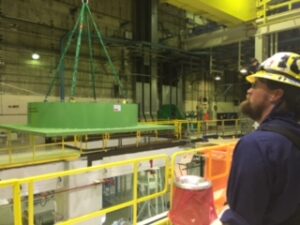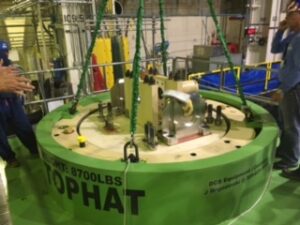One year ago we introduced our new ability to simulate complex radiation profiles and thereby design the most effective shielding possible (‘NPO uses MCNP to simulate Dry Cask’, March 2016). Since then we’ve designed and built more than a few shielding systems using this new ability. Now the day has finally come where we can show how the simulation stacks up against the real world.
We were contracted to build a complete Dry Cask shielding package for a BWR plant that had never done a Dry Cask campaign before and who was using a storage system that had never been used at a BWR before. There were a lot of firsts but no one was accepting that as an excuse. This campaign was to come in under dose and ahead of schedule.
Our portion of the project included a Shield Bell with an integrated floor shield (another first), a lid shield, and annulus gap shielding. The design challenge was to work within a given weight limit and provide the maximum dose reduction possible without adding any weight to the work platform. It was a perfect opportunity to try out our new tool and the first project to do so.
The simulation works by inputting a gamma/neutron spectrum along with the geometry and chemical composition of every material present. The subsequent calculation allows you to see the predicted dose rate at any point in space. A number of different shielding configurations are analyzed until the best combination of material and geometry is revealed.
We are very pleased to say that the shielding was very well received, successfully implemented, and performed better than expected. We are also very pleased to say the accuracy of our simulation tool has been validated and predictions are conservative (Actual reduction greater than estimated). For locations we were able to obtain measured dose rates before and after shielding the actual reductions were 50% and 60%, predicted values at those locations were 34% and 44% respectively.

